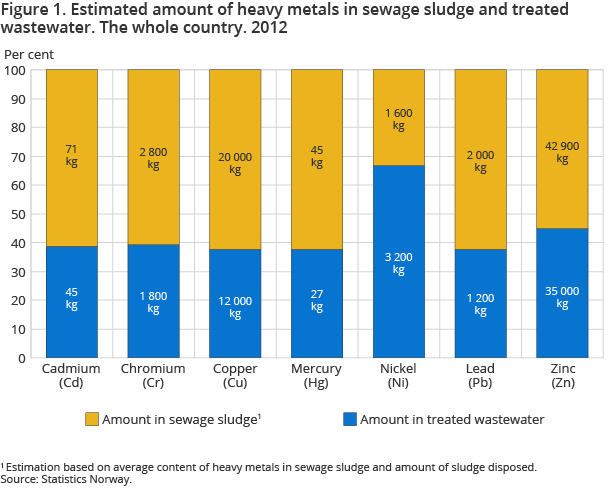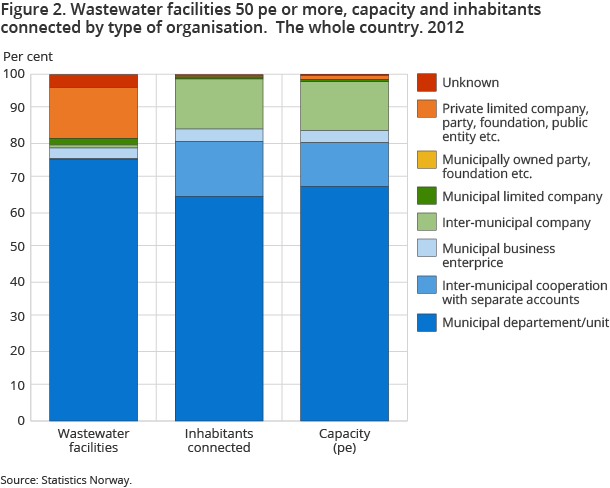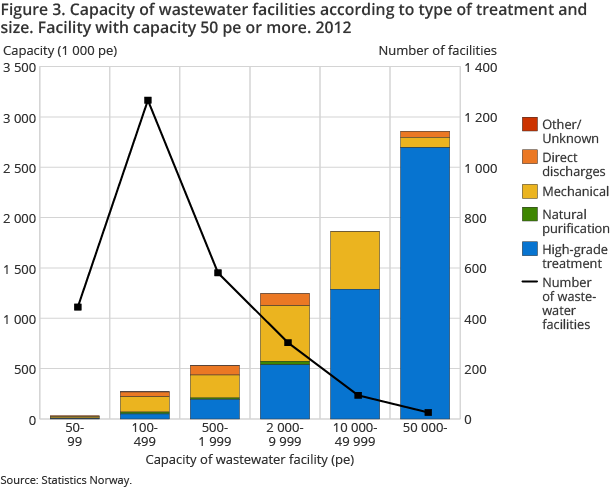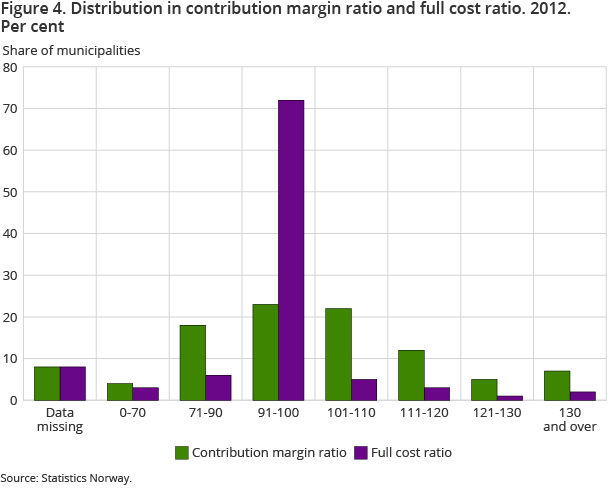Content
Published:
This is an archived release.
70 kg of mercury from municipal wastewater
Estimates for 2012 show that Norwegian wastewater facilities discharged around 25 kg of mercury into fresh waterways and coastal areas, while 45 kg was absorbed into sewage sludge. Wastewater from 62 per cent of the population is treated biologically and/or chemically.
| 2012 | Per cent | ||
|---|---|---|---|
| 2011 - 2012 | 2008 - 2012 | ||
| Number of wastewater facilities, 50 pe or larger | 2 685 | -0.7 | -2.9 |
| Capacity of wastewater facilities 50 pe or larger (1 000 pe) | 6 786.7 | 1.1 | 5.6 |
| Discharge phosphorus from wastewater facility 50 pe or larger (tonnes TOT-P) | 824.4 | -0.1 | 2.8 |
| Discharge organic material from wastewater facility 50 pe or larger (tonnes BOD5) | 38 132 | 6.3 | . |
| Disposal of sewage sludge to soil improvement (tonnes dry weight) | 102 387 | 11.6 | 12.3 |
| Used in agriculture | 70 092 | 9.7 | 2.9 |
| Used in parks or green spaces | 13 869 | 37.8 | -11.4 |
| Delivered to soil producers | 18 426 | 3.2 | 149.4 |




This is revealed in the new report Municipal wastewater: Expenditures, investments, discharges, treatment and disposal of sewage sludge 2012 – Wastewater fees 2013 (in Norwegian only, English abstract).
In comparison to national discharge and emission data, mercury from wastewater constitutes around 7 per cent of the total (according to Miljøstatus the total discharges and emissions in 2010 were around 0.9 tonnes). Mercury is considered to be one of the most dangerous environmental poisons and can have chronic toxic effects even in low concentrations. The authorities aim to continuously reduce discharges and use, with the aim of achieving a complete stop to discharges by 2020.
Furthermore, in 2012, the total level of lead from wastewater amounted to 3.2 tonnes, while cadmium totalled around 120 kg.
825 tonnes of phosphorous
For 2012, the discharges of phosphorous (tot-P) from the municipal wastewater sector have been estimated at 825 tonnes. This is around the same level as the year before. Per inhabitant connected, this discharge corresponds to 0.19 kg per year.
The phosphorous treatment efficiency of the wastewater sector as a whole has been estimated at 70 per cent.
Three out of five connected to high-grade treatment
In 2012, 62 per cent of Norway’s population was connected to high-grade treatment plants – biological and/or chemical treatment. This constitutes an increase from 59 per cent in 2010 and 60 per cent in 2011. Chemical/biological treatment as opposed to mechanical treatment can remove more of the pollutants from the wastewater before being discharged into rivers and water systems. This applies in particular to phosphorous and organic material, but also other types of pollutants.
Furthermore, the statistics show that 19 per cent of the population was connected to mechanical or other types of treatment, 3 per cent had direct discharges and the remaining 16 per cent of the population were connected to small wastewater facilities (less than 50 pe).
Around 2 700 wastewater facilities serving 84 per cent of us
Estimates for 2012 show that a total of 2 685 municipal wastewater facilities (capacity 50 pe or more) were in operation for the whole or part of the year. These wastewater facilities treat wastewater for approximately 84 per cent of the population, which is one percentage point up from the year before.
75 per cent of wastewater facilities under municipal control
Almost 75 per cent of the 2 685 municipal wastewater facilities are organised directly under the municipality. Private facilities in comparison constitute around 15 per cent, and are usually small in size (low capacity/few people connected).
Furthermore, only a few facilities treat really large quantities of wastewater in Norway, with 4 per cent of the wastewater facilities being 10 000 pe or larger and accounting for almost 70 per cent of the total capacity of the wastewater sector (6.8 million pe). In comparison, facilities less than 2 000 pe constitute as much as 84 per cent of the facilities, but only account for 12 per cent of the total capacity.
Slight increase in costs of wastewater services
In 2012, the total cost for all municipalities was NOK 5.87 billion. This constitutes an increase of 3.3 per cent compared to 2011. The costs related to the wastewater sector are made up of capital costs and operating costs. The increase mentioned is due to an increase in operating and capital costs. The figures for the entire country are calculated based on the data reported in KOSTRA, with estimates for data missing. The estimates are based on data reported last year and average figures from the groups of municipalities in KOSTRA.
Wastewater fees are determined by the municipalities in accordance with the full cost principle. Local conditions such as patterns of built-up areas, topography, bedrocks in the ground, the need for pumping stations and treatment requirements are all factors behind the variation in fees.
A total of 62 per cent of the population live in municipalities with a contribution margin ratio of more than 100 per cent, which means that the incomes from fees are above the fee calculation basis. At the same time, a total of 77 per cent of the municipalities have a full cost ratio between 91 and 110 per cent, and these municipalities are home to 92 per cent of the population. A major part of the population lives in municipalities where the costs for wastewater services are covered by fees.
The full cost ratio reflects the relationship between the income from fees and the fee calculation basis, and includes fund provisions and purchases from funds.
Where do heavy metals in wastewater come from and where do they go?Open and readClose
Heavy metals in wastewater originate mainly from storm water (run-off from roads and streets) and cleaning and maintenance of cars and bikes, and washing of clothes. Wastewater is generally a minor source for heavy metals. At the treatment plants, part of the heavy metals will be absorbed into the sewage sludge – removed from the water phase – while another part will pass through the plant, released into the waterways together with treated wastewater.
Contact
-
Gisle Berge
E-mail: gisle.berge@ssb.no
tel.: (+47) 48 12 19 97
